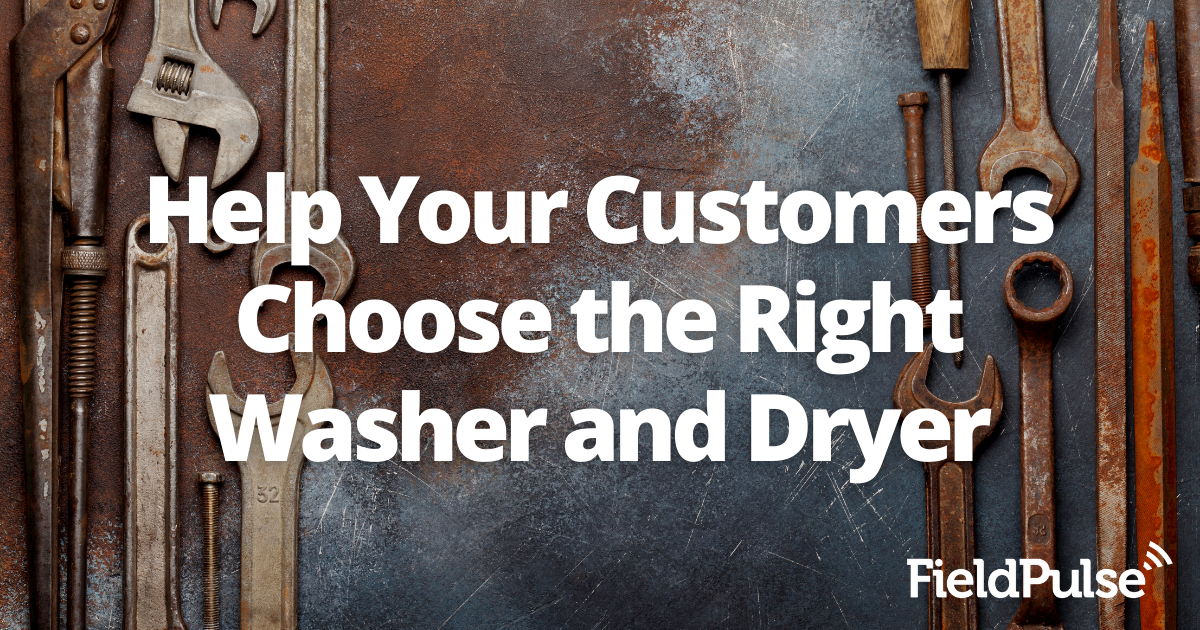When helping your customers find the right washer and dryer, the most important approach is to establish the customer’s priorities and find a model that meets their needs. In many cases, it means going back to the basics. Convenient, modern features may be attractive. However, your customers may prioritize efficiency, dependability, and size/dimension over the latest trending technology.
As a professional, your role is to help your customers make smart decisions that create a positive experience and minimize problems down the road. Your guidance is something they value and will appreciate. It will also earn you loyal customers as your business grows. Below we look at how you can help your customers choose the right washer and dryer.
It’s Nice…But Does It Fit?
Laundry spaces range from small closets to large utility rooms. Fortunately, there are a variety of brands and models available to match your area regardless of its size. Standard washing machines measure roughly 27 inches wide with a capacity of three to six cubic feet. Compact machines measure around 24 inches wide and have a capacity of up to three cubic feet. Matching dryers typically follow suit with identical dimensions.
Regardless of the size of the washer and dryer, you will need plenty of room to transport them, install them, and use them. For, a customer needs to consider the following measurements before choosing a model:
- Doorways and hallways are generally 30 to 31 inches wide.
- Allow four to six inches between the rear of the appliance and the wall for hookups and accessories.
- Allow one to two inches of space around the appliance for proper airflow and maintenance.
- Top-loading and front-loading doors need up to 25 inches of clearance.
- On average, a stackable washer and dryer is 80 inches tall.
Washer vs. Dryer Capacity
Obviously, what happens to clothes in a washer is very different from a dryer. For this reason, you should consider capacity when helping your customers. Capacity involves more than just how much clothing the unit can hold. It also involves the relationship between the washer and the dryer.
Dryers are designed to hold more clothing than washers because clothing expands and takes up more space as it dries. For your customers to have the optimal experience, you may want to suggest that they find a dryer with twice the washer’s capacity. A dryer that holds twice the load is more likely to dry an entire washer load in one sitting.
Note: If you’re wondering about standard sizes for washers, here’s a basic rule of thumb.
- Compact washers are usually 2.30 to 2.45 cubic feet.
- Standard and high-efficiency top load washers are 3.1 to 4.0 cubic feet.
- Front-load, high-efficiency washers range from 4.0 cubic feet to 5.0 cubic feet.
- Most front loaders are between 4.2 and 4.5 cubic feet.
To find the ideal dryer size, simply double the washer dimensions above.
Front-Load vs. Top-Load Models
Whether the homeowner stacks the units or goes side-by-side largely depends on their preference and the room layout. However, there are other factors to weigh, such as cost, efficiency, and overall performance value.
Top-Loaders
If your customer is on a budget, they may prefer a top-loader washing machine. However the washing bins on top-loaders can be deep, making it difficult for a shorter person to reach the bottom of the bin. Therefore, you’ll want to recommend a machine with a bin that the customer can reach without difficulty.
Today’s models are often designed without the inner agitator (the spinning rod in the middle of the bin) and the hollow bins are lined with stainless steel. The design allows the machine to operate at higher speeds, which pushes more moisture out of the clothes. As a result, they dry more efficiently.
Front-Loaders
Front-loading washers are more convenient, however, the added convenience does cost more. In addition, front-loaders require more maintenance due to the added features. Some models are also notorious for attracting mold and dirt buildup. However, the models are efficient and more effective at cleaning dirty laundry.
Energy-Efficient Models
Contrary to popular belief, efficiency is not a standard component of washers and dryers – at least not from a marketing standpoint. Efficiency buttons, lights, selectors, and labels are often presented as an additional feature or a perk of buying a high-end model. But, as a professional you know that this going on, and can help your customers save money by recommending high-efficiency models that do not come with high-efficiency price tags.
So the question is, what determines if a model is efficient? An energy-saving washer and dryer has the following features or qualities:
- Energy Star Certified
- Load sensing technology (uses the right amount of water)
- Impeller plat for gentle yet effective washing
- Design that creates improved water movement
- Multiple wash and rinse settings
- Low kWh usage
Bottom Line: The more valuable your information is, the more valuable your washer and dryer repair service becomes. Your customers will see you as a resource and not just someone they need to call when they have a problem. You can also play a vital role in saving energy and creating sustainable solutions in the home.
Upgrade Your Trade with FieldPulse
FieldPulse’s home service business software is the tool to help field service owners upgrade their trade. With FieldPulse, you’ll have everything you need to manage your business — all with top-notch customer service and support. Contact FieldPulse today to schedule a free demo.


